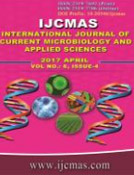


 National Academy of Agricultural Sciences (NAAS)
National Academy of Agricultural Sciences (NAAS)

|
PRINT ISSN : 2319-7692
Online ISSN : 2319-7706 Issues : 12 per year Publisher : Excellent Publishers Email : editorijcmas@gmail.com / submit@ijcmas.com Editor-in-chief: Dr.M.Prakash Index Copernicus ICV 2018: 95.39 NAAS RATING 2020: 5.38 |
The development of reliable, eco-friendly process for the synthesis of nanoparticles is an important aspect of nanotechnology. In the present study, the extracellular synthesis of Silver nanoparticles was done by reducing aqueous Ag+ with the culture supernatant of four different bacterial strains viz. Bacillus flexus, Bacillus pseudomycoides, Cronobacte runiversalis, and Kocuria rosea. The formation of silver nanoparticles was confirmed by the change in colour from colorless to brown. The synthesized nanoparticles were characterized adopting suggested instrumentations. In case of UV-Visible spectroscopy, four strong peaks were observed at 430, 410, 420 and 420 nm respectively which confirmed the synthesis of AgNPs. FTIR analysis confirms the presence of elemental silver and reveals the dual function of biological molecule responsible for the reduction and stabilization of AgNPs in the aqueous medium. The XRD showed that silver nanoparticles produced are crystalline in nature with size ranges from 30 to 70 nm. The SEM, shows that produced silver nanoparticles are spherical, Pseudo spherical in shape. However, it also showed an indeterminate morphology. The silver nanoparticle also showed traces of agglomeration. Silver nanoparticles synthesized through this biosynthesis method have been known to posses’ great interest in recent times due to their reported advantageous properties as well as application in a diversity of fields.
 |
 |
 |
 |
 |